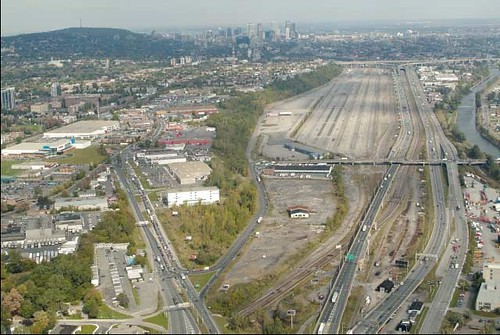
A huge neglected strip of nature running almost to the city’s core? While the downtown portion of this slope teams with traffic, what is stunning about the Falaise St. Jacques – approximately half the hill’s length, running from the Turcot Interchange in the east to Angrignon in the west – is its wildness.
Accessing the falaise from St. Henri is not for the faint of heart. After walking under the ghostly rush of traffic on the Turcot Interchange, one passes a barbed wire enclosure where two German Shepards welcome you with raspy barks. After a Transport Quebec sign informs you that you are now trespassing, you are in the Yards and can begin looking for the foot trail that follows the escarpment.
In 2001 the City of Montreal declared the Falaise St. Jacques a significant eco-region worthy of protection. After only a few short minutes on the trail, we soon realized why. More than simply a slope separating the once heavily-industrialized areas below from residential areas and commercial above, the hill provides a natural divide as well. At the foot of the hill, where Otter Lake once ran into the Rivière St. Pierre, a plethora of tall reedy plants suggests that the Falaise retains a link to its natural, wetland heritage.
Perhaps even more surprisingly than its diverse plant-life, a fresh layer of snow provided us with a catalogue of the various animals that call the falaise home. We spotted rabbit prints across a fallen log, fox prints and a gamut of small birds, squirrels and the other common city critters. I am reminded that living between human settlements, in neglected spaces, life in Montreal can be bountiful and rich.
But to imagine the Falaise St. Jacques as a purely natural space would be a mistake. For years it has been a dumping ground for car tires, used car batteries, empty paint cans, old truck transmissions, plastics of all kinds and colours, and no doubt other junk hidden by the snow. It is no wonder that the planners and engineers at Transport Quebec have no objection to placing autoroute 20’s six lanes at its foot. If the Falaise St. Jacques is going to actually be protected, it needs to be integrated into Montreal’s system of parks and recreational spaces.
For those interested in walking the Falaise St. Jacques, I should mention another access point: the hill opens up around Cavendish and a trail descends from St. Jacques boulevard and connects with the foot path below.

2 comments
My wife and myself participated in the walk and we greatly appreciated the opportunity to do so. In his description Jacob shows himself to be a lot more observant than myself.
I agree fully with his conclusions. To me it offers the potential for a perfect East West footpath within a linear park totally protected from motor traffic.
Les Amis de Meadowbrook is getting together with groups that support the Falaise with a plan for a Trame Verte.
We have been working on the idea of a green belt in the south west of Montreal with Patrick Asch of Heritage Laurentien.
It’s possible to link up the Parc des Rapides, Douglas Hospital grounds, Angrignon Park, the Falaise, and Meadowbrook. Residents of the west and south west would be able to enjoy bicycle paths, cross country ski trails and walking trails. This could bring tourists in and provide other benefits to this area. Eventually this could also be extended to Lachine.
This is quite urgent, because of the rebuilding of the Turcot Interchange, which could affect the Falaise. There are also plans in the works to develop Meadowabrook Golf Course.
If any one knows of community groups and other individuals in the south west that would be willing to support this idea, please e-mail:
savemeadow@yahoo.ca